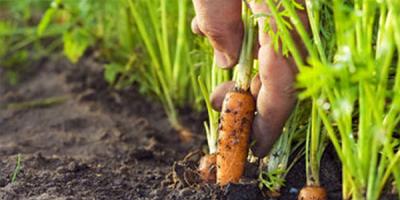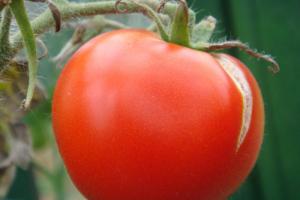The most common and common mistakes when growing seedlings celery root.
Sowing dates
Celery seeds are sown in central regions in February. The sowing deadline is mid-March. When sowing late, large root crops do not have time to grow.
Seed treatment before planting
Celery seeds take a long time to germinate. The reason for this is the oily shell structure that covers the seeds. And proven methods such as soaking and bubbling will be beneficial and speed up germination. These methods are relevant when sowing is late in March.
The soil
Celery grows well in non-acidic, rich humus soils. The soil must be loose and moisture-absorbing.
Sowing seeds
Celery seeds germinate only in the light, without covering them with soil. High temperatures this culture doesn't like it. Seeds germinate in 7-10 days, but sometimes you have to wait up to three weeks for germination. Be sure to remove weak and shading plants. Thickened crops are weakened seedlings.
Seedling care
High temperature in the room and lack of lighting lead to stretching of seedlings. Therefore, the first thing to do is put them in a bright place. Seedlings will feel normal at moderate temperatures and insufficient lighting.
Celery is a slow-growing crop. During the seedling period, the soil should not be over-moistened or dried out. Water the “babies” only when the soil dries out. The temperature for seedlings from 17 to 20 ° C will be the most comfortable.
Picking seedlings
The seedlings are replanted when the first or second true leaf appears, pinching off the main root by 1/3.  The transplant is done at the level of the heart. Use small pots, 3x4, 4x4, 3x5 cm in size. If the plants are poorly developed, feed them with liquid complex fertilizers.
The transplant is done at the level of the heart. Use small pots, 3x4, 4x4, 3x5 cm in size. If the plants are poorly developed, feed them with liquid complex fertilizers.
Grown celery plants are planted in the beds no earlier than May 10, otherwise they may bolt.
Not every vegetable grower can grow celery, since not all gardeners know how to sow root celery for seedlings. Many, even experienced vegetable growers, could not wait good harvest this crop, because they did not figure out for themselves in advance how to properly grow root celery and how to plant petiole celery for seedlings.
What conditions are necessary for growing root celery?
 Harvesting celery in the fields
Harvesting celery in the fields The main problem in the process of growing this garden crop is the long ripening time of root celery. Planting of root celery seedlings is carried out at the end of the last winter month, or in the first week of spring, as it prefers a mild, not frosty climate.

Sow directly into your soil personal plot This plant can only be grown in the southernmost regions of the Krasnodar and Stavropol Territories, Chechnya and Dagestan.
In order to harvest a good harvest of root celery in advance, you need to take care of the quality of the soil in the garden.

The garden plot prepared in the fall is dug up and added to the soil. organic fertilizers. In the spring, the bed is loosened again and fertilizers are applied.
The following components are good for this purpose:

- ash;

- infusion of chicken manure, as well as any preparations intended to improve the quality of the soil. Special means can be purchased at flower shops.
In other words, in order to sow celery for seedlings in 2018, preparatory work should have been done in the fall of the previous year.
 Celery planted in a garden bed
Celery planted in a garden bed Early varieties of the plant, when grown in the southern regions, can be planted directly into the garden bed, and with late crops of root celery, sowing seedlings is required. One of the main conditions for obtaining a large quantity of high-quality harvest is the presence of high-quality seeds.

In order for the planting of root celery seedlings to be successful, all selected seeds are placed in a jar with clean, warm water and kept in it for 24 hours. Those seeds that float to the surface as a result of soaking are unsuitable for planting root celery seedlings. Sorted high-quality seeds are sown into the soil to a depth of 1 centimeter in a peat base.
Agronomic features when growing root celery

Knowing the rules for planting root celery for seedlings, the gardener can be sure that he knows how to plant petiole celery for seedlings.
Root celery is one of the crops that require special care and close attention from the vegetable grower; all the problems of growing this crop are related to its characteristics. The point is that the stage active growth and celery takes five months or more to ripen. Thus, in the northern regions this plant simply does not have time to ripen before the onset of cold weather.

Since culture has too long periods ripening and for this reason it is necessary to plant root celery for seedlings.
In order to grow a good harvest of this crop, you need to know how to sow root celery for seedlings.
Also, in order to ensure a good germination rate of root celery seeds, it is necessary to select high-quality seeds.
This is done like this:

- the purchased seeds are placed on moistened gauze; keep in a warm room for a week;

- Place in the refrigerator for a period of 10 days.

- After these manipulations, the seeds are placed in a jar of water, and those that float to the surface are removed.
Only those seeds that lie on the bottom are suitable for sowing seedlings.
How to properly prepare root and petiole celery seeds for sowing for seedlings
Sowing of seedlings is carried out towards the end of the last winter month, approximately two and a half months before planting root celery shoots in the soil. Seedlings begin to be planted with preliminary manipulations.

The seeds of the plant must be soaked in order to ensure accelerated germination.
The fact is that they do not wake up very actively, since the seeds contain a large number of essential oils, which complicate the process of active swelling in the peat base. The seed may not germinate from three weeks to one month, especially in cases where the air in the room is too dry and the soil contains little moisture.
There are two main methods for processing seed material of petiole and root celery:

- In the first method, the seed is kept in oxygen-enriched water for a whole day. After this, they are treated in a weak pink solution of manganese for about 1 hour. All manipulations are carried out in a warm room.

On last stage preparation, the seed is washed in warm water, and then sow seedlings.
- In the second method, the seed material is kept in a weak manganese solution - Pink colour about an hour, then washed in warm boiled water.

After this, root celery seeds are soaked for 18 hours in any of the special preparations offered by specialty stores. Good feedback The product "Epina" has it. To create the product at the required concentration, you will need two drops of the product per 120 milliliters of water. All manipulations with seed material are carried out at room temperature. Only after the preparation has been carried out can seedlings be sown.
The manipulation plan for both seed treatment methods cannot be changed and must be strictly followed.

At the last stage preparatory work, the seeds are evenly scattered on the surface of a moistened cloth and left in a warm room for germination at a room temperature of at least 20 degrees C.
Only after this can seedlings be sown.
Planting root celery for seedlings

To sow celery for seedlings in 2018, the majority of gardeners use pots that are placed on window sills.

For this purpose, specially prepared nutrient soil is poured into containers intended for planting root celery seedlings, in which 1 kg of humus mixed with sand is added to 3 kg of peat.
Then add 250 grams of ash and a teaspoon of urea to the prepared mixture.

The sprouted seeds are thoroughly dried in the shade, after which root celery is planted as seedlings in boxes filled with moistened soil. You can first place the seeds on a strip toilet paper at an equal distance from one another. Gluing seed material to a strip of paper occurs due to a paste cooked in advance from flour.

There should be at least 3-4 cm between planted seeds.

The paper tape with seeds is sprinkled with a thin layer of sand, which is constantly moistened with a spray bottle as it dries. Sand is needed because outdoors the seed germinates faster. Planting petiole celery for seedlings occurs in approximately the same way.
How to properly care for celery root seedlings

The container with the sown seeds is placed in warm room and covered with film material.

If the room is not well lit, then lighting fixtures are installed above the boxes with seeds.

From the moment of sowing to the germination of the first shoots, as a rule, it takes a little less than two weeks. As the soil dries, the sprouts are moistened with a spray bottle (the water should be room temperature).
It is strictly forbidden to water plants at this stage of growth, because this will result in the appearance of a so-called “black leg” on the surface.

To ensure normal growth of seedlings, containers with seeds are kept at temperatures not lower than 22 degrees.

After the first shoots form, the film is removed, and the container with the crops is moved to the most sunny windowsill, while the temperature in the new place should be at least 16 degrees.
Features of picking

A month and a half after planting, celery grows inactively, increasing its volume very little. After one month from the moment of sowing, when the seedlings have 2-3 well-formed leaves. The seedlings are thinned out, leaving a distance of five centimeters between the leaves.
They also carry out plant transfers, suitable for this:

- peat pots;

- disposable cups;

- special boxes for crops, greenhouses, greenhouses.
The required soil density for growing seedlings must be at least ten centimeters.
Important. During the picking process, the plant is immersed in the prepared soil mixture up to half, without exposing the root system; such an error can provoke slow development.
When transferring the shoots to the greenhouse, they are placed at a distance of six centimeters, with 7 to 8 cm left between the rows. The transplanted plants are carefully watered and covered with moistened paper for two days.
Most suitable temperature regime to ensure rapid rooting of plants after picking, fifteen degrees, and at night it can drop to 11 degrees.
Feeding and watering plants
Caring for growing sprouts includes loosening the soil, watering and fertilizing. For the first time, feeding is carried out twelve days after the picking procedure.

For this purpose, a nutrient mixture is used, for the preparation of which take one teaspoon of nitrophoska per bucket of water.
Water, spending 1 tablespoon of solution per 1-2 plants.
If the leaves of the plant look too weak, then it is fed with urea at intervals of two weeks. To avoid damaging plant leaves with chemicals, they are washed with warm water after fertilizing.

A week before transferring the crop shoots to a place of permanent growth in open ground, the plants begin to harden. To do this, they are taken out into the air, first for the whole day, and then at night.

Seedlings are planted in the garden after five developed leaves appear. This happens approximately 60 days after planting petiole celery seedlings. Five days before the seedlings are moved into the ground, the plants are taken out into the air; before this, they are actively watered for two hours.

A few hours before planting petiole celery, the sprouts are well watered with warm water so that the soil is well soaked.
Suitable time for planting radicular celery vegetable beds– from late April to mid-May. Planting time depends on the climatic conditions of the region. In the southern regions, during warm weather, celery can be replanted earlier.
Planted before plants have better productivity compared to those that were planted in the ground later. Planting too early can result in too many flower stalks.
Seedlings that have managed to grow up to 15 cm in height and have 4-5 developed leaves take root well and produce a good harvest.
Weak, poorly developed shoots will not produce a good harvest.
Sowing petiole celery for seedlings

Sowing petiole celery for seedlings and caring for this crop remains the same as when growing root and leaf celery.
Planting of petiole celery for seedlings is carried out at the end of February at the beginning of March. Why is the soil mixture pre-prepared?
To sow petiole celery for seedlings, the seeds are processed and germinated. After this, you can plant petiole celery as seedlings.
Only the process of fertilizing must be carried out taking into account several rules. The plant loves good watering and loose soil.

At the same time, you should not allow too active flooding of the soil, as this will lead to rotting of the root system. To avoid drying out the soil needs to be mulched.
Fertilizers are applied to the soil every two weeks. For this purpose, it is best to use organic mixtures, such as an infusion of chicken manure or nettle.
Sowing petiole celery for seedlings, like sowing root celery, requires special skills and knowledge from the vegetable grower. However, if you follow the basic rules for preparing seeds and selecting them, feed and water the plants in a timely manner, then the effort spent will lead to an excellent result. The main thing when planting celery is to take into account the ripening time of the plant.
Thus, planting root celery for seedlings and further care This plant should be cared for extremely carefully, adhering to all growing rules.
For celery lovers, it's time to plant seeds for seedlings.
Celery can be leaf, root and petiole. For gardeners in the middle zone, root celery is of greatest interest (stem celery is almost never grown in Russia).
Leaf celery produces a large number of tender, fragrant leaves on fairly thin roots. There are varieties with curly leaves. The root of leaf celery is not large.
Root celery has larger and stiffer leaves, there are significantly fewer of them, but a large round root is formed, reaching 400-800 g or more. Its flesh is white, tender, very tasty, and it keeps well in winter. Small root vegetables can be grown at home in winter for greenery.
Root celery- a real delicacy. Anyone who has ever tried celery salad will probably be looking for seeds to grow it on their own plot. Root celery, in addition to good taste, has a whole bouquet healing properties, but it is especially useful for older people. Celery has diuretic and laxative properties and prevents the formation of stones. It is used for obesity, it has good action on cardiovascular and nervous system, improves sleep, metabolism, helps with headaches, increases physical and mental performance.
Root celery- a plant with a long growth period (170-180 days), so it is grown only through seedlings. You cannot grow a good large root crop without seedlings. Leaf celery has a shorter development period; it can be sown directly into the beds, but its yield is significantly less than when grown through seedlings.
Be careful when choosing your seeds to avoid disappointment during harvest. Planting material is considered to be of the highest quality imported manufacturers, and among domestic seeds, “Russian Size” and “Aelita” seeds deserve attention. Due to the peculiarities of the Russian climate, it is better to take only early varieties celery, capable of ripening in 120-150 days. For use as food, it is more convenient to grow varieties with large root crops. Don't forget to check the expiration date of the seeds!
You can safely sow any variety of leaf celery; they have no obvious differences. Root celery has few varieties. Considering that the Maxim and Delikates varieties have medium-sized root crops, they can also be grown on heavy soils.
VARIETIES OF ROOT CELERY
MIDDLE EARLY
Diamond
After a growing season of 150 days, round, smooth root vegetables ripen, weighing on average 200 g. The pulp of Diamant celery root vegetables perfectly retains its white color even after cooking. The variety is distinguished by powerful dark green leaves and resistance to bolting.
Cascade
Technical ripeness of root crops occurs 150 days after emergence. Ripe root vegetables have a round shape, medium size and white flesh, the color of which does not change even after cooking. The lateral roots are located low.
Apple
The leaves of this variety, collected in a small rosette, have a pleasant aroma. The ripening period of root crops can last from 90 to 160 days (depending on weather conditions and agricultural technology). Ripe, smooth, round-shaped root vegetables have a snow-white color and are rich in sugars. The weight of root vegetables varies from 80 g to 140 g. From one square meter In a vegetable garden you can get up to 5 kg of root vegetables. Root celery of the Yablochny variety is distinguished by its disease resistance and shelf life.
Kornevoy Gribovsky
Root crops gain marketable weight in 120-150 days, the weight can vary from 65 to 135 g. The pulp of the roots is light with a few yellow spots. The rounded root vegetables of the Kornevoy Gribovsky variety have remarkable taste, high aromaticity and can be eaten both fresh and dried.
Medium ripe varieties
Albin
120 days pass from the first shoots to technical ripeness celery. The root vegetables are round in shape, about 12 cm in diameter, the white skin at the top of the root has a greenish tint. The main part of the root crop of the Albin variety protrudes above the ground, the root system grows only in the lower part. Albin has excellent yield; the roots can be consumed fresh or cooked; the white pulp is resistant to the formation of voids.
Strongman
170 days after germination, the root crops gain weight up to 400 g. The root crops are large, round, white with a slight yellow tint. The snow-white pulp is rich in sugars and mineral salts and has a bright aroma. The leaves form a semi-raised rosette; the lateral roots of the Silach variety are located low.
Egor
From the time the first shoots appear until the root crops fully ripen, 180 days pass. Smooth, large, rounded root vegetables of the Egor variety have a yellowish-gray skin and white flesh. The variety is valued for its high sugar content in root crops, rich aroma and high marketability.
Giant
A variety with a vertical rosette, large leaves and large aromatic roots, on which thin roots are located in the lower part. The rounded root vegetables reach a weight of 700 g, their skin is light beige in color, and the dense, juicy pulp is white. The Giant variety is valued for high yield, weighty root vegetables with a pleasant aroma and sweet taste.
Late varieties
Anita
The growing season lasts on average 160 days. The variety has erect leaves and long petioles. Root vegetables weighing about 400 g are oval or round, with a light beige skin and snow-white pulp, which does not change its color during heat treatment. Thanks to high taste qualities Root vegetables of the Anita variety are used for cooking, for fresh consumption and for freezing. The variety is also valued for its resistance to bolting and high yield.
Maksim
This variety of root celery reaches ripeness 200 days after the appearance of young shoots. On rounded root crops, a small number of lateral roots are formed. The dense, creamy-white pulp has a delicate piquant taste, the weight of root vegetables reaches 500 g. The Maxim variety is excellent for long-term storage.
What does celery like?
1. Light. It is demanding of light, so it is grown in a lighted area; in the shade, celery does not produce large root crops.
2. Moisture. It grows well on high places, does not tolerate flooding. However, it requires sufficient soil moisture during the entire growth period. Celery grows poorly on dry soils, and the root crops are dry and rough.
3. This plant is cold-resistant, prefers moderate temperatures (12-20 ° C) for growth and development.
4. Fertile soil. Big harvest produces only on loose and fertilized soils. It is necessary to add organic matter (humus and compost) or peat to the soil mixture.
Seeds
Celery seeds are small, ribbed, oval, gray or brownish-brown in color.
Germination lasts only 1-2 years, so it is better to sow them fresh or test them for germination.
Celery is a crop with a long growth period (170-180 days), the seeds germinate very slowly (on the 15-18th day), so celery is grown only through seedlings. Root celery is sown for seedlings. Root celery is sown early - the first among vegetables. For subsequent cultivation in the ground (at first - under a film), sowing is carried out from February 15-25 to March 5(leaf celery for seedlings is sown on March 20-25).
Preparing seeds for sowing includes:
Sorting; germination test. Normal seed germination should be 70%, but not lower than 50%;
- disinfection and simultaneous removal of the shell from essential oil, preventing seed germination. To do this, keep the seeds (stirring) for 30 minutes. in water heated to 50-52 °C.
- germination-accelerating treatments. Barbation (I often use soaking in biostimulants) or soaking for 10 hours in Epinextra solution (2 drops per 125 ml of boiled water 23-25 ° C). The container with the solution and seeds is not closed so that the seeds do not suffocate.
- germination, about 3 days. (not required).
Growing seedlings

The soil mixture should be loose, permeable, loamy and peaty (but not too acidic), rich in humus.
Soil composition: peat, humus with the addition of coarse sand.
Selection of containers. For containers I use square milk cartons placed on their sides or small seed boxes.
Sowing. Celery seeds are small and germinate only in the light (!). Therefore, I sow celery in a special way.
I cover the container with watered soil with a 1 cm layer of snow, compact it and sow seeds in rows (this makes it easier to care for) every 3-4 cm (less frequently). After sowing, I do not sprinkle the seeds with soil (!): the snow will melt and the water will slightly draw some of the seeds into the soil. Most of The seeds will remain on the surface, this is not a problem; later they can be powdered with sifted soil. I cover the container with film and place it in a warm place (necessarily in the light!). Ventilate the crops daily, turning the film over, and moisten the drying soil with a sprayer. In such a mini-greenhouse, root celery seedlings grow strong and healthy. Swollen and hatched seeds will sprout on the 5-7th day, while when sowing with unprepared dry seeds, shoots appear on the 15-18th day. After this, I remove the film from the crops, and after 2-3 days I powder the seedlings (!), but do not sprinkle them with sifted nutrient soil or peat. Seedlings must be kept in the light.
Light. It is better to light the seedlings after emergence, since sowing is carried out early, when there is daylight
short. For the first 5-7 days (and not 2-3 days, as for most vegetables), additional illumination is carried out around the clock. In subsequent days, fluorescent lamps are turned on only in the morning and evening, and on cloudy days or in a poorly lit window - all day. During the first 30-40 days, the seedlings grow slowly: the seedlings are long and thin, and the less light, the more elongated they are.
Temperature for the growth of celery seedlings it should be 15-18 ° C.
Water the seedlings with water at room temperature. The first time watering is carried out 4-5 days after the emergence of seedlings (in more early dates if necessary, if the soil is dry, you can sprinkle it with water). Then watering is carried out every week. I water the seedlings very carefully, first with an eye dropper, and then 1-3 tbsp. l. under the root. Excessive watering should be avoided. After watering, always (very carefully) loosen the soil. 2-3 days before planting seedlings on permanent place it is watered abundantly.
Transfer. When 1-2 true leaves develop (about 25-30 days after germination), I advise dropping one celery sprout into small glasses from milk bags. My observations have shown that picking can be done later, at any age, since celery is easily transplanted. When picking, you need to pinch the tip of the root so that it develops better, and when planting, deepen the stem in the soil by 1/2-1/3 of its length. After picking root celery, the bottom of the stem quickly begins to thicken, and without picking this will happen later. In leaf celery, picking stimulates tillering. Picked seedlings have a squat and strong stem.
If you grow seedlings in boxes (without picking), then they must be thinned out: first, all late-emerging and stunted seedlings are removed, and then several plants at once, so that there is a distance of 5-7 cm between the remaining ones (they add priming). Without thinning, plants become very elongated and weak.
Feeding seedlings. The first feeding is carried out 2 weeks after picking (thinning), when the plants take root. If the seedlings have pale green, yellowish leaves, better feeding apply urea (1/2 tsp per 1 liter of water). With normal growth, plants are fertilized with complex fertilizers, for example “Mortar” (the dose is the same). You can use liquid concentrates of humic growth substances - “Ideal”, “Gumi” (the dilution dose is indicated on the labels) 2 tbsp. l. per plant.
If necessary, carry out a second feeding 7-10 days after the first, when the plants have 3 true leaves, increasing the dose of fertilizer to 1 tbsp. l. for 5 liters of water. Celery responds well to sodium and potassium nitrate; they are used for the second feeding (the dose is the same).
Hardening. Before planting in the ground, seedlings are hardened off, i.e. accustom to natural growth conditions. If there is not enough space for the seedlings in a bright window, they can be moved to an area and hardened off in a greenhouse, taking them outside and gradually increasing the time spent in the air.
The timing of planting root celery (55-60-day-old seedlings) in beds under film is April 15-20, in open ground - May 5-10.
Seedlings of leaf celery (35 days old), when sown after March 25, are planted in the ground in the first ten days of May (in good weather - after April 20). This is a cold-resistant plant and does not require additional covering with film.
Before planting in the ground, standard celery root seedlings should have 5-7 leaves and a thickened stem at the bottom. Seedlings of leaf celery have practically no thickening, and there should be several leaves.

Be sure to ensure that the root is not buried - the growing point should remain at soil level. This is an important condition for how to grow root celery large and even, without a “lush beard” of adventitious roots. For the same purpose, leave a distance of at least 30 cm between plants and between rows.
Growing celery root will be more successful if you adhere to the following rules:
- You cannot cut off all the leaves of a growing root celery, otherwise the root crop will not ripen; cut off only the outer leaves;
- hilling root celery is contraindicated - it provokes the growth of lateral roots, as a result of which the root crops lose their presentation;
- when the root crop begins to thicken, to give it evenness rake the soil from the tops of the plants and carefully cut off the side roots with a knife;
- In order for the root crop to turn out juicy, with a rich taste and aroma, the soil in the garden bed must be kept moist (not watered), watering is necessary not only throughout the summer, but also until October - this way the celery heads will grow better;
- water the celery at the root;
- until the foliage over the bed closes, you need to regularly loosen the rows;
- For good growth It is recommended to feed root celery with a herbal solution when the seedlings are in open ground begins to grow, feed it a second time with mullein infusion, the third time (until July 15) with Azofoska, the fourth time (from mid-July) with monophosphate, and when the head is tied, it is spilled with a solution of boric acid;
- During the summer, root celery requires two or three fertilizing with nitrogen fertilizers - no more is needed, otherwise the plants may be affected by scab and septoria.
The harvest of celery grown according to all the rules can be harvested before the onset of autumn frosts, in the first ten days of October. To make it more convenient to pull root vegetables out of the ground, first spill the ground with water. And when harvesting, try not to damage the delicate skin of the celery.

Growing root celery is now rarely practiced by gardeners, but in vain. Caring for it has its own peculiarities, but is not difficult and does not take much time. Right choice seeds and selection of variety will ensure good germination. Compliance with planting dates will allow the root crop to gain weight and ripen. At regular care the fruits will be juicy, tasty and without defects.
Seed selection
When choosing seeds, you should give preference to early and large-fruited varieties. The seeds must be fresh.
Root celery has a long growing season. From sowing the seeds to harvesting takes 4 to 5 months. This must be taken into account when choosing a variety. If in the southern regions spring begins early and any variety has time to ripen, then in middle lane Only early ripening varieties are suitable for cultivation.
It is advisable to opt for large-fruited varieties. The celery root vegetable has irregularities on the surface, and when peeling it is necessary to cut off a thick layer of skin. On large fruits this is not noticeable, but on small fruits there is almost no pulp left after peeling.
Celery root seeds quickly lose their viability and have a short shelf life. When purchasing, choose seed only from last year’s harvest. Old seeds are unlikely to germinate and sowing time will be missed.
Sowing dates and seed preparation
In the middle zone, celery is grown only by seedlings. Sowing seeds in open ground will not lead to success.
The period for planting seeds for seedlings is from the second ten days of February to mid-March. If planted earlier, the seedlings will stretch out and the development of the root crop will be delayed. If sowed later, celery will not have time to gain weight by autumn.
There are two ways to speed up the germination of celery.
- The seeds are wrapped in a damp cloth and placed in a warm place. It is necessary to ensure that the fabric does not dry out. Dried seeds are unsuitable for planting. When the white sprouts hatch, plant them in the ground, in a tray. small size.
- Planting material is washed in very warm water. The temperature should be between 35 and 40°C. To carry out this procedure, the seeds are wrapped in cotton cloth and placed in a container of water. When the water begins to cool, it is replaced with new one. Washing time is 2 hours. Before planting, the seeds are lightly dried until crumbly.
Sowing seedlings
For planting you will need a small tray, soil and film for covering.
Celery has two soil requirements:
- the soil should not be acidic;
- Clayey, heavy soil is not suitable.
Soil can be bought at the store, universal will do, for seedlings. You can take nutritious soil from the garden. Before planting, the soil is moistened with a weak solution of potassium permanganate.
Rules for planting seedlings
- It is recommended to plant according to a 2x2 cm pattern. To easily place the seeds on the surface of the soil, you can use a toothpick or a match. Its tip is moistened with water, and the seed easily sticks to it.
- Seed placement depth is maximum 0.5 cm.
- The soil must be moist and should not be allowed to dry out.
- To make it easier to care for and maintain a humid microclimate, a film is stretched on top.
- The tray is placed in a warm, dark place. Celery germinates best in the dark.
If planting material a lot, then the seeds can be scattered on the soil involuntarily. After emergence of shoots, the excess ones are removed.
The method of sowing on snow has proven itself well. To do this, make grooves 0.5 cm deep in the seedling tray and cover them with a layer of snow. Seeds are placed on the surface. The snow gradually melts, and the seeds appear at the desired depth. When using this method, drainage holes must be made at the bottom of the tray to drain excess moisture.
Seedling care
As soon as shoots appear, it is necessary to remove the film. The tray with seedlings is moved to a bright, cool place. Recommended temperature is 15-18°. In such conditions, the seedlings will turn out strong, the seedlings will not stretch.
Caring for celery seedlings involves keeping the soil moist. At first, celery seedlings are very thin and weak. To avoid damaging them, it is better to replace watering with spraying from a spray bottle. The water should be at room temperature.
When the seedlings grow up and two true leaves appear on them, pick them. For this you can use peat cups, disposable tableware volume 200 or 300 ml, deep food containers.
When replanting, the celery root must be shortened (pinched) by 1/3. This will give impetus to the beginning of the formation of root crops.
Seedlings must be planted deep in the ground, up to the cotyledon leaves.
Celery leaves grow in a bunch, so when picking, you should not bury the growing point or cover it with soil.
Caring for pickled celery is simple:
- the place should remain cool and sunny;
- the soil should not dry out;
- if there is still a lot of time before planting in open ground, then the seedlings need to be fed with complex mineral fertilizer.
A good seedling is considered to be one that has formed 3-4 strong leaves 15-17 cm high.
Transplanting
The date must be chosen so that warm weather sets in and the return of night frosts is unlikely. Typically, celery is planted in the garden in mid-May.
It is advisable to prepare the bed in the fall: remove weeds, add rotted manure, and dig up the soil. When planting celery, it is necessary to remove the roots of perennial weeds from the soil.
When choosing a place for celery, you need to consider the following:
- celery does not grow well in acidic soils;
- in frequently flooded areas, root crops are susceptible to fungal and bacterial diseases;
- if the soil is heavy, a drainage layer on the bed is required;
- Celery does not like fresh manure.
The best time for planting is a cloudy day. On a sunny day, it is advisable to plant in the evening, when the sun stops burning.
The distance between plants should be:
- 40 cm – for large-fruited varieties;
- 25 cm – for medium-sized people.
The seedlings are deepened into the ground to the same height at which they grew in cups.
Caring for newly planted celery is to protect it from night frosts. If the weather forecast promises a drop in temperature, the bed should be covered with agrofibre. If in the fall celery easily tolerates light frost, then low temperatures have an unfavorable effect on young plants: instead of growing root crops, celery produces a peduncle on which seeds are set.
Shelter from overnight spring frosts is necessary for young celery to prevent flower stalks from forming.
Caring for celery in the garden
Caring for celery in the summer includes:
- weeding;
- loosening;
- keeping the soil slightly moist;
- fertilization;
- removal of outer leaves;
- raking soil away from root crops;
- removal of lateral roots.
Weeding and loosening are carried out in the first half of summer. Once the celery leaves grow and close, weed growth stops.
Watering is carried out as the soil dries. In order for the root vegetables to be juicy and tasty, the soil must be constantly moist. Important condition: you need to water at the root. Drip irrigation makes maintenance easier.
If the celery bed has been filled with fertilizer since the fall, then you can do without adding organic matter. It is enough to add boric acid, and in the second half of summer - complex mineral fertilizer.
If the soil is depleted, then organic matter is added in the first half of summer. It could be mullein infusion, bird droppings, ash. Celery responds well to the addition of nettle infusion or any other herb.
Growing root celery is a little different from growing other root vegetables. To get a full-fledged, large fruit without flaws, special care is required.
- The soil around the celery is raked so that the top of the fruit is above the ground.
- The lateral roots growing on the upper part are cut with a sharp, clean knife.
- The outermost leaves, the base of the stem of which has cracked and began to dry out, must be removed. Tender leaves are torn off from cut stems. They can be used for food or stored for the winter. They have a spicy taste.
Such care must be carried out once every 7-10 days. If after watering or rain the root crop is again covered with earth, then unhilling will have to be done more often. By autumn, almost the entire part of the fruit should be above the soil level.
Only such care allows you to get large, even fruits. With regular watering, their flesh will be dense, juicy and tasty, and the bitterness content will be minimal.
Harvest and storage
Root crops are harvested in October, when the night temperature drops to minus 3°. Such fruits are stored for a long time and contain the greatest amount of nutrients.
To avoid damaging the root crops, they are dug up with a pitchfork. They are left to dry in the fresh air for several hours. Then they prune:
- the roots are removed almost completely, leaving a few large roots;
- The leaves are cut off, leaving petioles 5 cm long.
The best place to store celery is in the basement. Clean, damp sand is poured into the boxes. The root crop is deepened into it by 1/4. As the sand dries, it must be moistened.
A quick guide to growing celery
- Preference should be given to early large-fruited varieties.
- Seeds for seedlings are sown in February or early March.
- They are planted in the garden when the threat of frost has passed. At first, it is advisable to cover it at night.
- The soil should be constantly moist.
- Watering is carried out at the root.
- Once a week, the soil around the root crops is raked.
- All upper side roots are cut off.
- The extreme yellowed, drying out or very large leaves are removed.
- Fertilizing is carried out 2-3 times during the summer.
- Root crops are removed from the garden when the night temperature begins to drop below zero.
Celery root is quite popular vegetable crop, which is easy to grow even for a novice gardener. Everyone already knows him well beneficial features, spicy taste and aroma. , features of care and secrets of obtaining bountiful harvest are described below.
Growing root celery seedlings
Most often, celery is sown to produce seedlings, which are subsequently planted in open ground. You should start sowing root celery seeds for seedlings from the end of February or in the first ten days of March. If you miss this deadline, the plant will not have time to produce a good harvest.
Any container is suitable for planting seeds. It is only important that it is easy to transplant celery seedlings from it in the future. The selected container is filled with a mixture of earth and humus in equal parts. To make the soil more loose, it is worth adding a small amount of river sand. This will also give the soil good drainage properties. The sand should be pre-roasted, and the soil can be disinfected by dousing it with boiling water a few days before planting the seeds.
 Learn how to grow root celery in open ground from seedlings
Learn how to grow root celery in open ground from seedlings Before planting, the seeds are placed on a damp rag and moistened with warm water. The seeds are moistened for approximately 3 days. This process helps better germination celery. Seeds prepared and pre-soaked in warm water are sown on moistened soil in prepared grooves about 1 cm deep. Seeds are sown at a distance of 3-4 cm. Celery seeds do not need to be sprinkled with soil, and they will quickly sprout.
To maintain the desired microclimate, the crops are covered with film or glass. Celery root seeds germinate well under the following conditions, namely:
- air temperature – about +24 degrees;
- moist soil;
- good lighting.
After about 3 weeks, when the celery plant has 2-3 leaves, it needs to be picked. This promotes the formation of smooth and attractive-looking root vegetables.
Planting root celery in open ground
Experienced farmers advise planting celery seedlings no earlier than the onset of May warmth. For planting, you need to prepare a suitable plot of land. Celery root grows well in loose and fertilized soil. It is better to transplant on one of the warm days in sunny weather. If over the next week the ambient temperature is warm, the seedlings will take root immediately and will not be wasted. 
Root celery plants are planted at a distance of about 30 cm from each other. The plant should not be planted too deep. Experience shows that in this case the root crops will be crooked and ugly. If one day the weather turns bad and gets colder, it is recommended to protect the seedlings by covering them with film.
Growing root celery in open ground requires the gardener to carefully care for the delicate plant. To do this, seedlings need:
- regularly water by spraying;
- loosen the soil between plants;
- remove weeds;
- fertilize the soil;
- fight plant pests and diseases.
Root crops are ready for digging around mid-autumn. Most often, farmers dig them out with a pitchfork. The vegetable is cleared of soil, the foliage is removed, and the root crop is dried.
We invite you to watch a video about growing root celery in open ground:
Growing root celery in open ground not too troublesome task. But the farmer will have a vegetable rich in vitamins and microelements, which will undoubtedly strengthen the immune system and support the health of the summer resident in the winter. Continue reading on the website
















